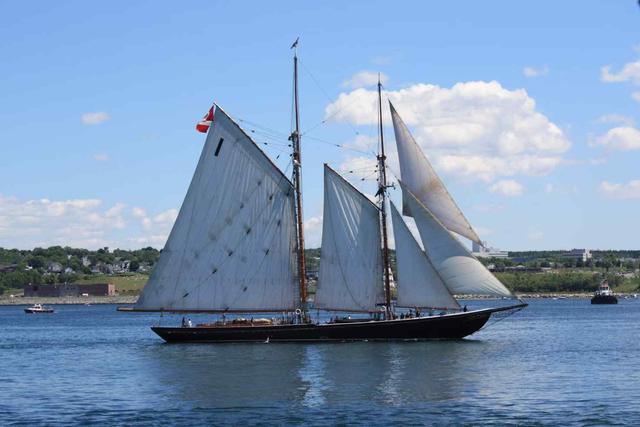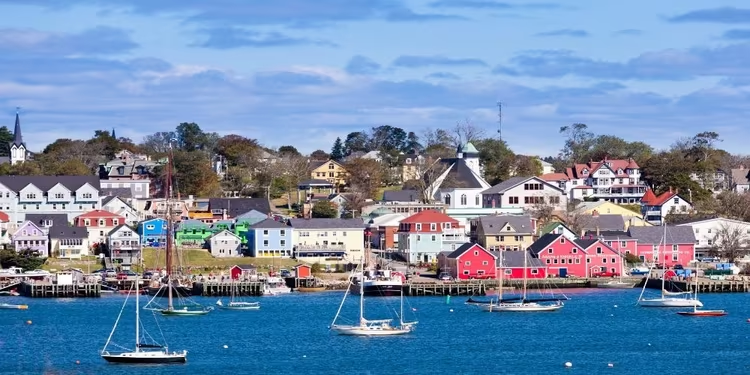My Bookings
Please Enter Your Booking Code To Find Your Booked Tour!

Facts about Lunenburg, Nova Scotia
Table of Contents
Lunenburg, Nova Scotia, is a picturesque coastal town. It is a traditional seafood port with a rich history and culture. Since 1995, this UNESCO World Heritage Site has been celebrated for its magnificent 18th-century buildings and maritime heritage. So, if you are interested in familiarizing yourself with the unique peculiarities of the past and present, this beautiful place will be a great choice. Join me as I share interesting stuff about Lunenburg that will help you understand more about this wonderful town.
Who Were the Settlers of Lunenburg, Nova Scotia?
For centuries, the Mi'kmaq people lived in the area around Lunenburg and Mahone Bay. In the 1620s, French settlers (Acadians) arrived and lived alongside the Mi'kmaq. They got along well, traded, and even married into each other's families. Between 1680 and 1868 European settlers arrived in Lunenburg principally of German, Swiss, and French origin.
Lunenburg was established in the year 1753 when the British transported Protestant settlers from Switzerland, Germany, and France to Nova Scotia. This move had the purpose of equalizing the French Catholic power and the settlers were granted free lands. The Foreign Protestants from Europe played roles in setting up Britain’s dominance and inciting necessary economic growth. The town’s culture and, especially, the architecture were influenced by settlers of German and Swiss origin.
What are the Facts about Lunenburg, Nova Scotia?
Lunenburg, Nova Scotia, is a charming town that mesmerizes visitors of all ages. Here are the fascinating facts, and fun experiences that delight adults and kids alike:
Historic Facts about Lunenburg
- Lunenburg, Nova Scotia, was founded in 1753. Lunenburg is named after King George I's ancestral home, Brunswick-Lüneburg.
- The British established it as a Protestant settlement. They wanted to counter French Catholic influence in the region. It was intended as a planned settlement and still has a recognizable grid plan today.
- The founding families were involved in the growth of industries in Lunenburg, especially fishing, which formed the basis of the town’s economy.
- At the time when European settlers started to set their foot in the region, Lunenburg was home to the native people known as the Mi’kmaq. They were completely dependent on food that was available in the forests and the seas.
- Lunenburg’s history, geography, and culture provide information on the various heritages a visitor can learn from within the town through available museums and other cultural institutions.
- Lunenburg grew to become one of the greatest centers of the offshore fishery most notably on the Grand Banks. It used to be a major fish processing center and remains an important part of Nova Scotia's fishing industry.
Interesting Facts about Lunenburg
- Lunenburg’s Old Town was put on the UNESCO list of World Heritage Sites back in 1995 due to its well-preserved layout and countless structures. It is considered Britain's best-planned colony.
- Lunenburg is the birthplace of the legendary schooner Bluenose II, built in 1963. It is a replica of the original Bluenose. The original Bluenose was a celebrated racing ship and fishing vessel.
- The area of Lunenburg’s waterfront is well known, with many bright, variously colored buildings. Tourists come to the town primarily because of the stunning historical architecture that is present in most parts of the town. Lunenburg’s many colorful buildings are the key symbols of its history.
**Fun Facts about Lunenburg for Kids**
- The Lunenburg buildings are not only old but very brightly painted! I believe that children will love the look of the town because the houses are painted in bright colors: red, yellow, blue and green. The narrow streets of the city are also worth a visit; strolling down these will feel like walking through a fairy tale movie.
- The Atlantic Fisheries Museum is an ideal place for children and all those with families. Kids can learn activities and displays at the Fisheries Museum that recreate the past fishing experience of Lunenburg.
- The Offshore Fishery Museum is also motivating and quite interesting because it presents how one experiences offshore fishing through activities that are entertaining and informative for the children. The museum gives kids an opportunity to learn and make discoveries about the fascinating maritime history of Lunenburg in a fun way.
- The Lunenburg Historic District features a large range of colonial buildings and a highly developed maritime history. In this district of the town, there is a mix of British colonial and German architecture. This beautiful place with historical sites will mesmerize children!
What Is Lunenburg, Nova Scotia Famous For?
Lunenburg, Nova Scotia is famous for the following reasons:
Well-preserved Historic District
The historical neighborhoods of Lunenburg are evidence of its past. Colorful wooden houses, carriages, walkways, and the presence of structures of the 18th century significantly influence the atmosphere. This is because the towns and their residents have maintained an excellent culture of preservinghistorical buildings and structures.
The Bluenose II Schooner
The Bluenose II schooner is an example of Lunenburg and the maritime heritage of Canada. This is a replica of the famous Bluenose racing ship. Visitors can get on this sailing ship and enjoy many activities, waterfront views and beauty around them.
Rich Culture
Culture in Lunenburg town was most influenced by its seafaring past of the town. Annually the town has its festivals and events that highlight its maritime culture and past. The tourists can find many opportunities to enjoy the music, dance, and foods that were prepared by the Lunenburg community.
Fresh Seafood
Lunenburg is famous for fresh seafood and fresh seafood is part of the local meals. Whether it is lobster, scallops, or cod, local people and visitors enjoy tasty seafood. The restaurants as well as the seafood markets in this town provide several seafood dishes to suit everyday palate.
Discover the Magic of Lunenburg with Ultra Small Group Tours
Maritime Heritage
Maritime heritage is visible all over the town of Lunenburg. The fishing industry and how it has benefited the town economy is explained in the Fisheries Museum of the Atlantic and the Offshore Fishery Museum. Tourists love to know the struggle that fishermen in Lunenburg had to go through and their accomplishments in the fishing business.
Beautiful Coastal Scenery
Lunenburg is increasingly popular owing to the scenic landscapes that stretch along the shoreline. Most tourists like to take a stroll around the waterfront and watch the numerous vessels anchored in the port. The town is particularly notable for well painted houses and the beautiful views of the port.
Final Thoughts
In short, Lunenburg, Nova Scotia is a beautiful town with a well-maintained historical feel and a beautiful maritime culture. For the history lover who wants to know the past, Lunenburg offers a unique opportunity to step into the past while enjoying modern life. Visitors can explore the famous Bluenose II or take a stroll down the town's 18th-century streets. Known for its brightly colored houses, numerous historic sites, and rich maritime heritage, Lunenburg continues to attract many visitors. Ready to visit? If so, book your tour with See Sight Tours to have the best experience.Join Us to Experience the Wonders of Lunenburg
Related Blogs

Visiting Halifax in December
Embrace the holiday spirit with live music, art galleries, and outdoor events. Pack your layers and book your winter adventure now!
.webp%3Falt%3Dmedia%26token%3D34ede1cf-56c3-4ba0-bc9a-d5608053c9c0&w=128&q=75)
Aleena Mehmood

Visiting Halifax in August
Uncover why Halifax shines as a summer gem in August! Enjoy mild weather, explore top spots like Point Pleasant Park, and immerse yourself in the vibrant culture of Nova Scotia's capital.
.webp%3Falt%3Dmedia%26token%3D34ede1cf-56c3-4ba0-bc9a-d5608053c9c0&w=128&q=75)
Aleena Mehmood

Visiting Halifax in February
Glide across outdoor skating rinks, immerse yourself in cultural festivals, and uncover a winter wonderland brimming with unique experiences. Discover the magic of Halifax this February!

Ammara Younas
Quick Links
Book your Tour
Get in Touch
Toll Free
1-888-961-6584
Local
1-289-271-9767
© 2026 See Sight Tours. All Rights Reserved.
1-888-961-6584



